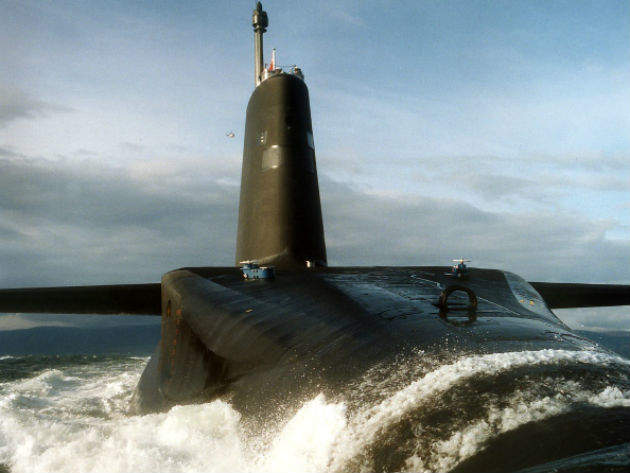

In recent months the UK Ministry of Defence (MoD) has taken its latest steps to ensure a replacement for the Royal Navy's Vanguard-class nuclear ballistic submarines (SSBNs) in the 2030 timeframe with a new class of boat, currently dubbed 'Successor'.
The update of the UK's nuclear deterrent – which is also looking at replacements for the current Trident missile system – has been an issue of major political debate.
The huge cost of replacing the deterrent at a time of austerity has raised eyebrows and the anti-nuclear stance of several of the UK's political parties – including some in the Labour leadership as well as the Scottish National Party (SNP) – has ensured that the subject remains in the headlines.
The UK Treasury is believed to be concerned about the ability of the MoD to manage and control the costs of large programmes. A number of high-profile projects, including the UK's aircraft carrier replacement programme, have had costs balloon as a result of both changes in specification and technical challenges.
Big money
In March of this year, the MoD announced that it was awarding some £642m in contracts for the Successor programme. The UK Secretary of State for Defence Michael Fallon announced the awards, stating: "Our nuclear deterrent provides the ultimate guarantee of our security and our way of life. That's why we are getting on with this investment. This money will support further design work, new infrastructure and the purchase of key parts such as engines and gearboxes, as well as jobs across the UK."
The contracts include £225m of investment for new facilities at BAE Systems' location in Barrow-in-Furness, a £200m contract to Rolls-Royce for the submarine's power plant, and investment in the common missile compartment (CMC) programme.
BAE Systems had already been awarded a £201m contract in February to carry out detailed work to develop the design of the submarine, including the layout of equipment and systems, and to develop manufacturing processes, including the production of early prototypes.
These awards in turn follow on from earlier significant packages awarded to BAE Systems for the design of the Successor submarine. This includes £643m awarded in 2012 for initial design, and £257m in 2015 to begin detailed design work.
In total, the last parliament announced that some £3.3bn would be spent on the assessment phase of Successor, although this has now been revised to £3.9bn. Although this may seem like a mammoth amount, it represents a significantly tighter budget than originally envisioned.
As part of the 2010 Strategic Defence and Security Review, industry committed to cost savings of some £900m over a ten-year period through the creation of the Submarine Enterprise Performance Programme (SEPP) to keep down costs on both the existing and the future submarine fleet.
When the latest package of work was announced in February, Chief of Materiel (Fleet) Vice Admiral Simon Lister stated: "We are now in the detailed design stage of the most technologically advanced nuclear submarine in the history of the Royal Navy.
"Building on cutting-edge developments carried out by the MoD, BAE Systems, Rolls-Royce and Babcock, this funding will allow us to continue to move forward with the programme."
Designing the future
It is too early yet to be able to say with certainty what the new successor design will look like. However, BAE Systems is believed to have been working on both a conventional cylindrical design (Concept 35) and a more advanced, but technically more challenging, design known as the 'Advanced Hull Form'.
Whatever design crystalizes during the current phase of work, it is likely to lean heavily on the work that BAE Systems has done on the Astute class and will look to further automate onboard systems, including the reactor.
The design and maintenance of the new reactors is the responsibility of Rolls-Royce, which has managed this aspect of the UK's nuclear submarine fleet for many years. So important is the work that Rolls-Royce does that there has been discussion about how to safeguard this part of the business in light of the company's recent problems in the civil aviation engines market.
The reactor design being developed for Successor is called PWR3. According to Rolls-Royce, it will deliver a huge improvement in terms of safety, integrity and availability, while at the same time reducing the through-life costs, a major part of the SEPP commitments made by Rolls-Royce to the MoD.
In 2013 the company signed a new ten-year, £800m enabling contract with the MoD that, according to the company, "provides the long-term commitment required to deliver a step change in operational efficiency, enabling cost savings in the provision of nuclear propulsion systems for the UK's existing and future submarine flotilla".
The PWR3 is being designed with the insight drawn from being able to assess what the US is doing with its own nuclear submarine fleet. The UK is believed to have a certain level of technical access to the US nuclear submarine reactor programme, and has been paying attention to what the US Navy is doing on its Los Angeles-class attack submarines.
Running alongside the development of the new SSBNs is the question of the ageing Trident II D5 missile itself. Many reports often confuse the name of the missile with the name of the submarines that carry it. At first there was discussion of the UK developing a new missile; however, technical and cost prohibitions mean that the UK will now participate in the US life extension programme for Trident instead.
The nuclear submarine programme is among the most contentious issues of the MoD's current job lot, with political, environmental and economic implications all worthy of consideration by decision makers. Although a final decision on ordering the submarines remains to be taken, for now it looks like work on Successor is to press onwards, providing fodder for supporters, critics and commentators alike for at least the next decade.




